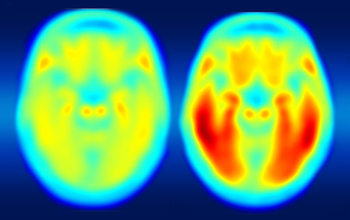Multimedia Gallery
Brain imaging links Alzheimer’s decline to tau protein
Scientists at Washington University are collaborating with the pharmaceutical companies AbbVie, Biogen and Eli Lilly & Company to investigate the buildup and clearance of tau protein in the brains of patients with Alzheimer’s disease. The positron emission tomography image on the left shows the average tau accumulation in the brains of cognitively normal people, averaged over many individuals. The image on the right shows the average amount of tau buildup in the brains of multiple people with mild Alzheimer's symptoms.
More about this image
A buildup of plaque and dysfunctional proteins in the brain are hallmarks of Alzheimer’s disease. While much Alzheimer’s research has focused on accumulation of the protein amyloid beta, researchers have begun to pay closer attention to another protein, tau, long associated with this disease but not studied as thoroughly, in part, because scientists only recently have developed effective ways to image tau.
Using a new imaging agent that binds to tau protein and makes it visible in positron emission tomography (PET) scans, scientists at Washington University School of Medicine in St. Louis have shown that measures of tau are better markers of the cognitive decline characteristic of Alzheimer’s than measures of amyloid beta seen in PET scans.
This research was supported in part by a grant from the National Science Foundation (DMS 13-00280).
To learn more about this research, see the University of Utah news story Brain imaging links Alzheimer’s decline to tau protein. (Date image taken: June 2015; date originally posted to NSF Multimedia Gallery: Jan. 25, 2017) [Image 2 of 3 related images. See Image 3.]
Credit: Matthew R. Brier
Images and other media in the National Science Foundation Multimedia Gallery are available for use in print and electronic material by NSF employees, members of the media, university staff, teachers and the general public. All media in the gallery are intended for personal, educational and nonprofit/non-commercial use only.
Images credited to the National Science Foundation, a federal agency, are in the public domain. The images were created by employees of the United States Government as part of their official duties or prepared by contractors as "works for hire" for NSF. You may freely use NSF-credited images and, at your discretion, credit NSF with a "Courtesy: National Science Foundation" notation.
Additional information about general usage can be found in Conditions.
Also Available:
Download the high-resolution JPG version of the image. (301.2 KB)
Use your mouse to right-click (Mac users may need to Ctrl-click) the link above and choose the option that will save the file or target to your computer.



